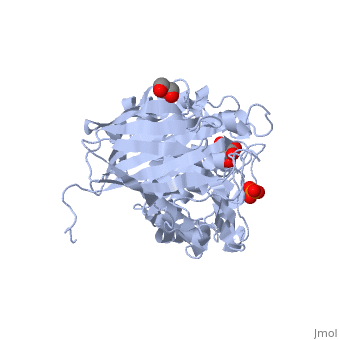This tutorial illustrates the quaternary structures of the human and E. coli β-glucuronidase enzyme.
Function
β-glucuronidase is a ubiquitous enzyme that catalyzes the hydrolysis of a glucuronide moiety from a variety of substrates. This enzyme is present throughout biological systems, including bacteria up through humans[1]. α-glucuronidase catalyzes the conversion of α-D-glucuronoside to alcohol and D-glucuronate[2].
Relevance
The E. coli form of β-glucuronidase (, PDB ID 3lpf[3]) is associated with the side effects seen with administration of the cancer chemotherapy drug CPT-11. This drug gets converted to SN38, a topoisomerase inhibitor, by the liver. The body adds a glucuronide group to this molecule (now SN38-G) to mark it for elimination, which partially occurs through the intestine. Once in the intestine, bacterial β-glucuronidase cleaves the glucuronide from the SN38-G, releasing the SN38 into the intestinal lumen. The released SN38 prevents cell division, compromising the epithelial lining of the intestines, a painful and dangerous side-effect of CPT-11 administration.
Selective inhibition of bacterial β-glucuronidase is desired to alleviate this side-effect of CPT-11 treatment, hopefully without inhibiting the human form of the enzyme[4].
Disease
Deficiencies in the human form of β-glucuronidase (, PDB ID 3hn3[5]) is associated with a disease known as Sly Syndrome (AKA Mucopolysaccharidosis VII -- MPS VII). This disease is characterized by mental retardation, short stature, macrocephaly, and enlarged joints. As is commonly seen with genetic disorders, patients with this disease present a spectrum of symptom severity, but the disease is always ultimately fatal.
Structural highlights
The structure of E. coli β-glucuronidase contains 4 identical subunits ().
The structure of the enzyme contains both α-helix (blue) and β-sheet (yellow) forms of , with the β-sheets arranged in β-barrels in an immunoglobulin-like fold.
The of BGUS contains [6].
3D Structures of glucuronidase
Glucuronidase 3D structures

